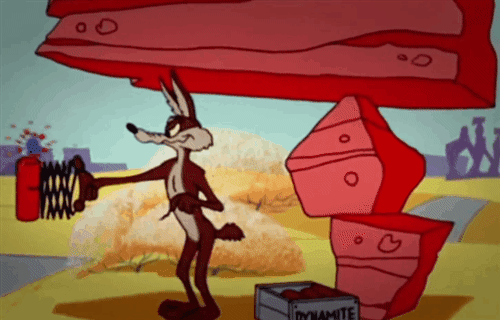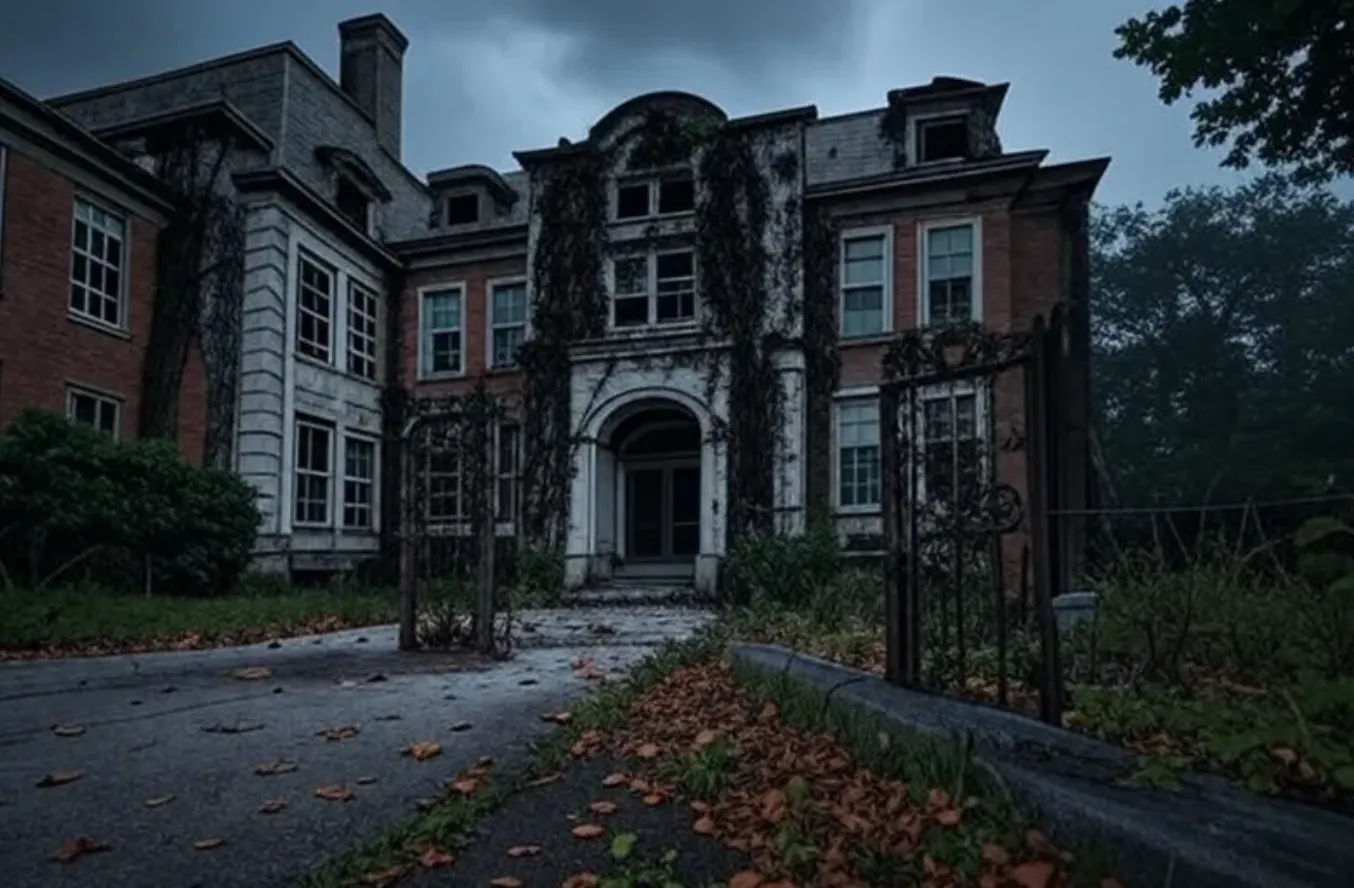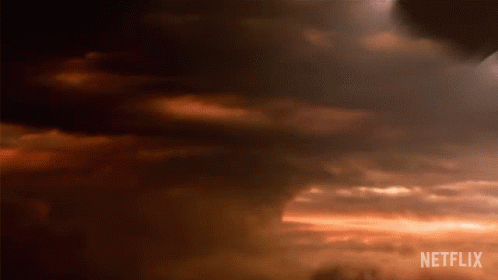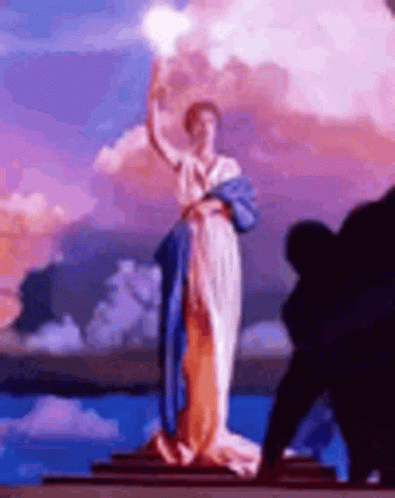What is it that feeds our battle, yet starves our victory?
January 6 Tapes?
Where are the tapes? Anyone, Anyone? Bueller? Johnson??
Paging Speaker Johnson…this is your conscience calling you out on broken promises.
Evading Reality
Many things the Left believes are simply not true. Right now the focus is on the size and scope of our government, and the many many billions of dollars the government has been spending on no-one-knew-what. None of that money is going to a key role of government. Which, after all, has the sole purpose of protecting rights.
And if you, Leftist Lurker, want to dismiss this as dead white cis-male logic…well, you can call it what you want, but then please just go fuck off. No one here buys that bullshit–logic is logic and facts are facts regardless of skin color–and if you gave it a moment’s rational thought, you wouldn’t either. Of course your worthless education never included being able to actually reason–or detect problems with false reasoning–so I don’t imagine you’ll actually wake up as opposed to being woke.
As Ayn Rand would sometimes point out: Yes, you are free to evade reality. What you cannot do is evade the consequences of evading reality. Or to put it concretely: You can ignore the Mack truck bearing down on you as you play in the middle of the street, you won’t be able to ignore the consequences of ignoring the Mack truck.
And Ayn Rand also pointed out that existence (i.e., the sum total of everything that exists) precedes consciousness–our consciousnesses are a part of existence, not outside of it–therefore reality cannot be a “social construct” as so many of you fucked-up-in-the-head people seem to think.
So much for Leftist douchebag lurkers. For the rest of you, the regular readers and those lurkers who understand such things, well here we go for another week of WINNING against the Deep State.
I confess that the novelty has not worn off.
Justice Must Be Done.
The prior election must be acknowledged as fraudulent, and steps must be taken to prosecute the fraudsters and restore integrity to the system.
Yes, we won this time around. Not only did we win, we got to KEEP that win instead of having it stolen from us.
But no one should imagine that that’s the end of electoral fraud. Much work needs to be done to ensure it doesn’t just happen again next time around. And incidentally to rescue those states currently in the grips of self-perpetuating fraud, where the people who stole the last election, make sure it’s easier to steal the next one.
This issue, though it’s not front-and-center right now, is not going away, and if we ignore it, we’ll pay the price. See the article above about the consequences of evading reality.
Lawyer Appeasement Section
OK now for the fine print.
This is the WQTH Daily Thread. You know the drill. There’s no Poltical correctness, but civility is a requirement. There are Important Guidelines, here, with an addendum on 20191110.
We have a new board – called The U Tree – where people can take each other to the woodshed without fear of censorship or moderation.
And remember Wheatie’s Rules:
1. No food fights
2. No running with scissors.
3. If you bring snacks, bring enough for everyone.
4. Zeroth rule of gun safety: Don’t let the government get your guns.
5. Rule one of gun safety: The gun is always loaded.
5a. If you actually want the gun to be loaded, like because you’re checking out a bump in the night, then it’s empty.
6. Rule two of gun safety: Never point the gun at anything you’re not willing to destroy.
7. Rule three: Keep your finger off the trigger until ready to fire.
8. Rule the fourth: Be sure of your target and what is behind it.
(Hmm a few extras seem to have crept in.)
Spot Prices.
Kitco Ask. Last week:
Gold $3,356.90/3,358.90
Silver $33.45/33.57
Platinum $1093.00/1103.00
Palladium $976.00/1016.00
Rhodium $5,180.00/5,630.00
FRNSI* 161.487-
Gold:Silver 100.057-
This week, markets closed as of 3PM MT.
Gold $3,288.30/3290.30
Silver $32.96/33.08
Platinum $1052.00/1062.00
Palladium $957.00/997.00
Rhodium $5,300.00/5,750.00
FRNSI* 159.168+
Gold:Silver 99.465-
I’m making a minor change here. Before, I quoted “ask” prices; i.e., the spot price corresponding to what you would pay a precious metal seller (if they actually paid attention to the spot price). The other price is “bid,” what they nominally pay you. The “bid” prices are what usually show up in the news. So from here on out it will be bid/ask, with the part after the slash corresponding to what I used to post. I’ll still use the ask prices to compute gold:silver and FRNSI.
Gold stayed above 3300 this week, but finally took a hit on Friday. Similar with the other metals. On the plus side for silver people, silver gained half an ounce (of silver) against gold.
*The SteveInCO Federal Reserve Note Suckage Index (FRNSI) is a measure of how much the dollar has inflated. It’s the ratio of the current price of gold, to the number of dollars an ounce of fine gold made up when the dollar was defined as 25.8 grains of 0.900 gold. That worked out to an ounce being $20.67+71/387 of a cent. (Note gold wasn’t worth this much back then, thus much gold was $20.67 71/387ths. It’s a subtle distinction. One ounce of gold wasn’t worth $20.67 back then, it was $20.67.) Once this ratio is computed, 1 is subtracted from it so that the number is zero when the dollar is at its proper value, indicating zero suckage.
Volcanoes
I’ve talked about streams. I’ve talked about glaciers (and judging from reactions, that was a better effort than the one on streams). Now it’s time–and we have the background–to talk about volcanoes.
Isaac Asimov was famous as a science fiction writer (most famous works being the Foundation Trilogy and the Robot stories and novels–he popularized the putative three laws of robotics) but he also was a biochemist and science popularizer. (In other words, when I read his work I realize how bad a job I am doing at this.) For decades he wrote a column for the monthly magazine Fantasy and Science Fiction. The editors gave him free rein. He usually wrote about some scientific topic. These got collected into books which I read, and oftentimes remember.
One of the essays I remember to this day is one he wrote in 1959. Asimov considered some of the most vital elements for living things (chlorine, sodium, potassium, sulfur, phosphorus, calcium, magnesium, iron, manganese, zinc, cvopper, molybdenum, cobalt and iodine). That list isn’t complete, obviously, but he was focused on soil and land life. He then compared the abundance of each in the soil to the abundance in living things. For instance, soil he lists as being five percent iron, but living things are 0.0027 percent iron (this is presumably before the IRS bleeds you dry and gets all your hemoglobin). The idea being that land life will never run out of iron, because it’s actually more strongly concentrated in dirt than it is in living things. But work it the other way around: sulfur is 0.052 percent of all dirt, but 0.104 percent of living things–it’s twice as concentrated in living things as it is in the soil. Conceivably, life could be fruitful and multiply…until it weighed half as much as the upper layers of earth and there was no more sulfur left. OK, that wouldn’t happen, would it? We’d never have that much living stuff on Earth. The king though was phosphorus, which is concentrated 5.9 times in living things, versus the soil. Given how little of the Earth’s upper layers is living things, there should be no issue with running out of phosphorus, though, right?
Well, no. If it’s locked up in solid rocks, it’s useless; plants can’t use it and therefore, we animal types won’t be able to either. Add to that the fact that these elements aren’t distributed uniformly, and well, after a lot of discussion he states that phosphorus is “life’s bottleneck.” (And that is the name he gave the essay.) Then he pointed out that phosphorus tended to wash out into the oceans (3 and a half million tons per year), and there was no way for it to come back other than in waterfowl poop, which recovers maybe 3 percent and in any case (let’s face it) won’t help Kansas out. Furthermore, the ocean water was already saturated in phosphorus, so it’s carrying as much life as it can, and so what phosphorus washed out of the land would settle to the bottom of the ocean in sediment.
(There, I just used the “S” word so now you might be thinking there’s actually geology coming up sometime.)
He actually suggested trying to capture some of that phosphorus so it wouldn’t be lost forever; given enough time the Earth’s land would be nearly lifeless simply for lack of usable phosphorus.
Actually, it’s not a bad argument. He sounded more worried about that than about running out of oil and coal (but then, he liked nuclear power). As he said at the end, “We may be able to substitute nuclear power for coal, and plastics for wood, and yeast for meat [ick!]…but for phosphorus there is neither substitute nor replacement.”
But there was one factor he didn’t take into account, and that’s no surprise whatsoever, because as I said before he wrote the article in 1959. No one could have taken that factor into account because we were only beginning to get a glimmer of it.
And the factor is (drumroll): Volcanoes…fed by plate tectonics.
Volcanoes can be thought of as Earth-scale zits popping, and thus regarded as a big negative, especially since they can be hazardous, but in fact they play a vital role, as they bring back to land what gets washed into the ocean. It’s by no means a fast process, since ocean crust can last up to two hundred million years, but it’s there.
Most volcanoes (I say most) appear either over subduction zones, or at divergent zones. The latter of these is the more intuitive, and the signature example is Iceland. As the plates move further apart, magma wells up to fill the gap and becomes ocean floor, literally hot off the conveyor belt. Magma welling up to the surface will of course make one think of volcanoes.
The first diagram shows the mid-Atlantic ridge from above, and also a profile, showing that the ridge comes comparatively close the surface, then slopes away to the more level bottom of the Atlantic ocean.
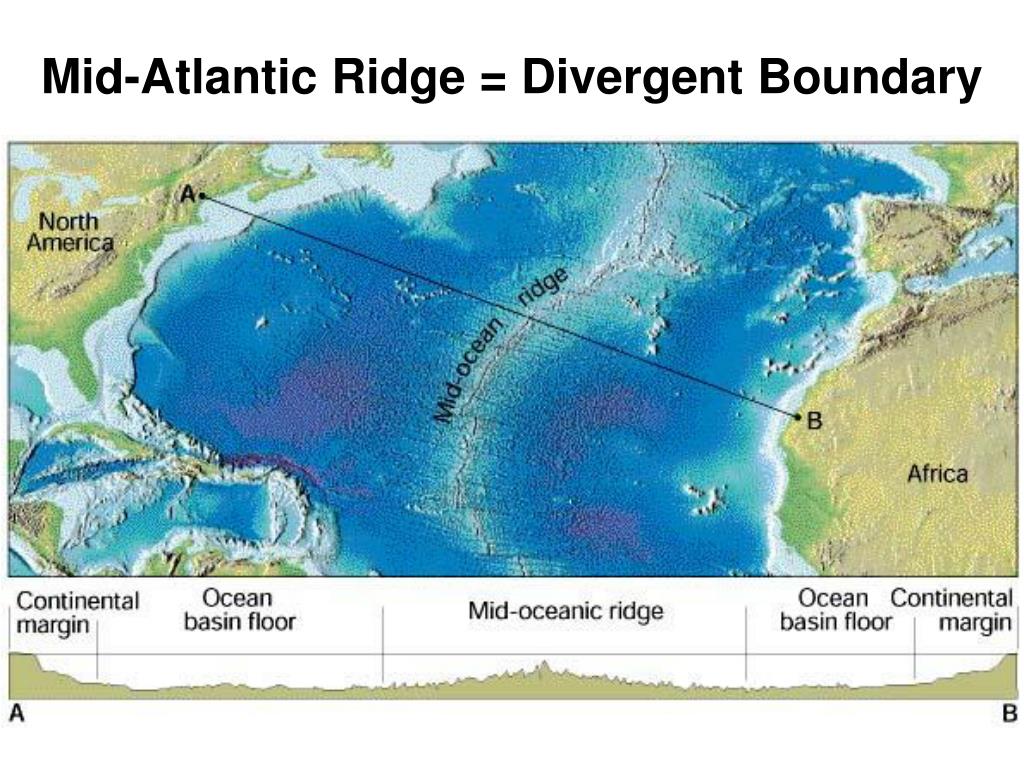
If that mid-ocean ridge should happen to break the surface of the ocean, it will form a volcanic island, and indeed we see this happen at Iceland, but also Jan Mayen, Pico island in the Azores, Ascension Island, St. Helena, Tristan da Cunha, Gough Island and Bouvet Island in the Atlantic ocean. In other oceans, the Galapagos islands are on a divergent boundary in the Pacific, and Rodriguez, St. Paul, Amsterdam, MacDonald, Heard, and Kerguelen islands in the Indian ocean.
(St. Paul and Amsterdam islands, by the way, are antipodal to Colorado; directly on the opposite side of the Earth from here. Kerguelen–a much larger but still-small island–is antipodal to the Montana/Alberta/Saskatchewan border. The rest of the Lower 48 is opposite of water.)
Why are there islands at these particular locations and not other places on the ridges? Hot spots. Which I’ll get to later.
But most volcanoes are on convergent boundaries, in particular subduction zones, which pretty much ring the entire Pacific ocean. To refresh memories, here’s a picture:

Why would there be volcanoes there? New crust isn’t forming, it’s disappearing. The ocean floor is basically being pushed down deep below the surface of the earth, presumably never to be seen again.
What’s happening is that the lighter continental rock sediments on the ocean floor are being heated, melt, and force their way upward through the denser rock until they reach the surface…and there they form volcanoes, usually not right on the subduction zone (which generally forms a deep oceanic trench like the Marianas trench) but a ways “downstream” from it; the sedimentary rocks need time to heat up and melt.
So this is how we get our continental crust (including phosphorus) back after it washes into the oceans! Asimov had no idea in 1959.
These account for almost every volcano out there, but of course there are two famous exceptions, Hawaii and Yellowstone. What accounts for them? Hotspots. Which I’ll get there later.
Volcanic lava tends to determine how explosive a volcano is. The more basaltic, the better; basaltic magma is very fluid and doesn’t have a lot of water trapped in it, so mid-ocean ridge volcanoes tend not to go “kablooey!” when they erupt. Near subduction zones, the magma is less basaltic (it has all that melted continental sediment in it after all) and has water trapped in it, so it tends to be explosive. As soon as that magma gets close to the surface the water in it flashes to steam and…well…(cued to 13:02):
Mount St. Helens was likely the largest landslide in recorded history. Worldwide. But it was by no means a superlatively large eruption as eruptions go. Big, but not humongous.
(The remainder of the video covers four other eruptions around the world, caught on camera.)
Also worth watching, the Smithsonian making itself useful (though you will want to stop it before it plays the next video):
Lava Types
There are two major types of lava flow, readily identifiable when they solidify. Logically enough they have Hawaiian names; the Hawaiians deal with lava like Inuit deal with snow.
The first is ‘a’a, roughly pronounced “ah, ah”. It tends to look chunky and jagged; the lava is a bit viscous. Then there’s pahoehoe (“pa hoy hoy”) which is much more smooth; it can look ropy because the top layer will get compressed and “scrunch up” as the still-liquid lava below it continues to flow. Here’s a picture of a new ‘a’a flow making its way across an older pahoehoe surface. The blocky chunks it is solidifying into are called clinkers.

Because lava tends to solidify at the top of the flow while the lower layers remain liquid, lava tubes can form, essentially caves through which lava once flowed. Here’s one in Hawaii:

you can see “step” lines in the walls, as later lava flows that didn’t fill the tube, used it as well.
Craters of the Moon National Monument in Idaho is probably one of the best places to see these sorts of things. It has cinder cones, lava fields that stretch to the horizon (it’s eerie to see almost no signs of life as far as you can see), pahoehoe and ‘a’a lava all over the place, and lava tubes. (And those are extremely unforgiving; I managed to bang my knee up pretty well tripping over something when I walked through one of the tubes–which was not nearly as smooth as the one in Hawaii; it was ‘a’a lava.)
Other Volcanic Stuff
Volcanic ash is the dusty stuff that gets ejected high into the atmosphere. It may not travel very far. When it comes down in thick layers it can consolidate into fairly soft rocks called tuff. (Tuff is sometimes erroneously called tufa, which is actually the name of a kind of marble.) Ash particles are 2mm or smaller, larger stuff gets labeled lapilli, at least until it reaches a diameter of 64mm.
Blobs of lava sent flying through the air are called volcanic bombs or lava bombs when they are more than 64 mm in diameter. They can fly many kilometers if they’re that small, but ones five to six meters across have been recorded, flying a few hundred meters. Here is an example from Kilauea:

If the eruption sends an already-solid rock through the air that would otherwise be a bomb, it’s a volcanic block. This example is from Cotopaxi in Ecuador.

Types of Volcanoes
There are quite a number of different types of volcanoes, including a number of types for volcanoes in the ocean–and I mean in the ocean, not above it–but the major ones are:
Cinder Cones. These are basically piles of small cinders, ash, clinkers that have spewed up vertically and fallen back to earth in a fairly neat, conical pile. They can range from tens to hundreds of meters tall. Mount Capulin in northeastern New Mexico is an example, they are also present in Craters of the Moon national monument in Idaho. (What’s a volcanic field doing in Idaho, nowhere near a plate boundary? Hot spots. Which I’ll get to later.)

Quite possibly the most famous cinder cone is Paricutin, in Michoacan State in Mexico. Picture this, a farmer in 1943 minding his own business when a vent in the ground opens up and starts spewing cinders. His name was Dionisio Pulido, and his account is:
At 4 p.m., I left my wife to set fire to a pile of branches when I noticed that a crack, which was situated on one of the knolls of my farm, had opened . . . and I saw that it was a kind of fissure that had a depth of only half a meter. I set about to ignite the branches again when I felt a thunder, the trees trembled, and I turned to speak to Paula; and it was then I saw how, in the hole, the ground swelled and raised itself 2 or 2.5 meters high, and a kind of smoke or fine dust – grey, like ashes – began to rise up in a portion of the crack that I had not previously seen . . . Immediately more smoke began to rise with a hiss or whistle, loud and continuous; and there was a smell of sulfur.
He–along with two whole towns–was SOL, his farm is now under a 424 meter tall cindercone (which did spew some lava). This happened over the span of nine years, and it has been dormant since then. Luckily only three people were killed.
Next we have the shield volcano. These will form when a volcano consistently erupts highly fluid, low viscosity lava, and have very gentle slopes. They’re named shield volcanoes because they reminded someone of one of those round hoplite shields (like Leonidas had), laying flat on the ground…just a low mound.
Hawaii is an example of a shield volcano. Here’s another in Iceland, named Skjaldbreidur…

…which is considerably easier to pronounce than Eyjafjallajökull, a troublemaker underneath a glacier. (Iceland Air, by the way, names its airplanes after Icelandic volcanoes.)

Mauna Kea/Hawai’i is the largest shield volcano on Earth, but Olympus Mons on Mars beats it handily. The total area within the escarpment is roughly the same as the country of Poland, and it is 21,900 meters tall (compare to Everest which is less than 9000, and to Hawai’i which measured from its base on the ocean floor, is 9330 meters tall.

And we can do combinations. Here’s a cinder cone that is in the San Francisco volcanic field near Flagstaff in Arizona…a nice symmetrical one, but the big black blotch upwards from it in the photograph is a basaltic lava flow from before the cindercone formed. (This field contains volcanoes anywhere between 1000 and 4 million years old. Mt. Humphreys (12,600 ft) is part of this field. The field is considered active, but likely not due for an eruption for a couple of thousand years.)

But probably the one you form a mental image of when you hear the word “volcano” is the stratovolcano…the type Mount St. Helens, and Ranier, and Shasta, and Hood, are.
Here is Mount Ranier:

It’s very prominent, when I first laid eyes on it on a road trip I immediately thought of “Fist of God” from Larry Niven’s Ringworld novels.
The internal structure will look something like this (vertically exaggerated):

Key to the diagram: 1) Large magma chamber 2) Bedrock 3) Conduit (pipe), 4) Base 5) Sill 6) Dike 7) Layers of ash emitted by the volcano 8) Flank 9) Layers of lava emitted by the volcano 10) Throat 11) Parasitic cone 12) Lava flow 13) Vent 14) Crater 15) Ash cloud.
These volcanoes tend to have a layered structure and in fact this is Broken Top, an eroded volcano in Oregon:

The crater at the top is often also known as a caldera, particularly if it’s big.
Another famous eruption in the Pacific Northwest is that of Mount Mazama. If you’ve never heard of that one, that’s because it is much more famous as Crater Lake. The 12,000 foot mountain erupted 7700 years ago–and it erupted so much that the magma chamber under the mountain was now empty. The peak of the mountain collapsed into the magma chamber, forming a caldera six miles across. The highest point on the rim of the crater is now 8,157 feet above sea level.
From the outside it’s an unassuming line of tree-covered peaks (they look like hills to me, honestly, since they don’t bust the tree line). From the inside, on the other hand:

I can attest that that is what the water actually looks like. This image has not been enhanced to exaggerate the color. The rim is hundreds of feet high or more. In the center is Wizard island, the result of a much smaller eruption a few thousand years ago.
Add it to your bucket list. I’m not joking, add it to your bucket list.
Volcanic Eruptions Ranked
Scientists will measure absolutely anything on a scale, and for volcanic eruptions they have the Volcanic Explosivity Index, or VEI, largely based on how much stuff the eruption spewed into the atmosphere.
Each step in the scale is ten times as much ejecta. Ten thousand cubic meters is a 1, a hundred thousand cubic meters a 2, and so on; at this rate when you get to a 5, that’s a cubic kilometer. The scale runs up to 8, 1000 cubic kilometers. When you realize that’s a cube six miles on a side, you realize that’s a LOT of crap spewing into the atmosphere.
So how do some famous eruptions stack up? Mt. St. Helens was a 5 (one cubic kilometer). Vesuvius in 79 CE was also a five. Pelee in 1902 was “only” a 4…but that volcano, on Martinque, destroyed the town of St. Pierre, killing 29,000-30,000 people almost without warning, the worst loss of life to a volcano of the 20th century. There were, by the way, three survivors. (That is not a typo. 3. Out of 30,000.)
Krakatoa, 1883, and Pinatubo, 1991, were VEI 6s, 10 cubic kilometers. Remember when the Phillipines kicked us out of the bases we had there? Well one of those bases got destroyed by that eruption.
Mazama was a 7, roughly 100 cubic kilometers of spew. Santorini in 1600 BCE was also a 7, and it was suggested it may have destroyed the Minoan civilization, but the timing isn’t quite right. There are Minoan ruins on what is left of that island, formerly Thera, now Santorini. And then there is Tambora, 1815. Tambora is on Sumbawa island, east of Java and Bali. Tambora’s eruption was heard 2600 kilometers away in Sumatra. In the northeastern US the next year, there was a persistent “dry fog” in the atmosphere from sulfur kicked up by this volcano, it dimmed the sun enough that people could see sunspots with their naked eyes. And that was the year without a summer; so much dust was in the upper atmosphere that massive crop failures were the result…world wide. It snowed June 6, 1816 in Albany, New York.
That was the biggest eruption in recorded history, but it is by no means the biggest eruption ever.
At a VEI of 8 we have Toba, on Sumatra, 74 thousand years ago, Taupo in New Zealand 26.5 thousand years ago, and, America is not to be outdone! Yellowstone, 2.1 Ma, and 640,000 years ago. (We’re due, folks…and the only safe place is Mars.)
Volcanic Plugs
One more thing I’ll cover, and that’s the subject of volcanic plugs. This is where lava hardens in the conduit of a volcano, and then the rest of the mountain erodes away.
By far the most famous of these is Devil’s Tower in Wyoming, made famous in Close Encounters of the Third Kind:

Aliens not included. [The wikipedia article on volcanic plugs hedges a bit and says many geologists believe that Devil’s Tower is a volcanic plug. Which means at least some do not.]
The striated look is because basalt likes to shrink and fracture into hexagonal columns, like this (the Giant’s Causeway in Ireland):

Wrapping Up
I said I’d talk about hot spots. And that’s true. I thought I’d do it today but I realized that subject is closely tied to a slightly deeper look at plate tectonics that I wanted to take. So I will (hopefully) do both next time. In the meantime I’ve given you quite a bit to digest already.



























